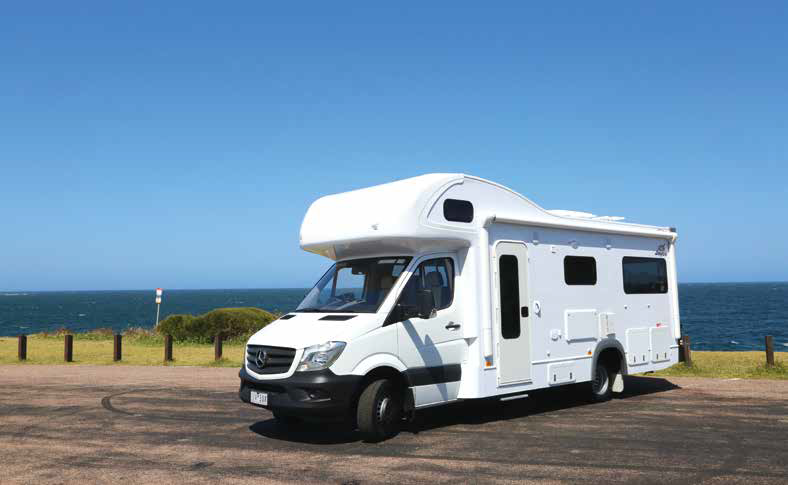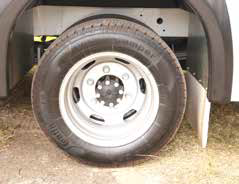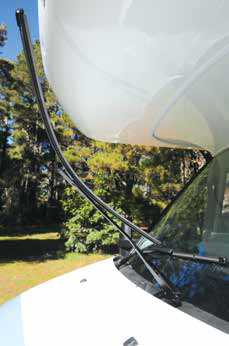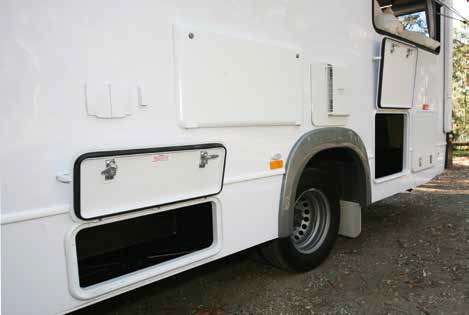
Don’t jeopardise your holiday by not keeping up with maintenance
Just the other day, KEA Tracks was on a visit to the Sunshine State. Not long after we drove away from the airport in our hire car, it started to rain quite heavily. We turned on the wipers only to get a smeary stain across the windscreen. Things did not improve when the window washers were utilised - no water in the reservoir.
A week or so prior, we had a relative visit our house complaining about difficulty in turning her car’s steering wheel. A very flat looking front wheel was the issue and air pressure in the tyre solved said problem. All this started us thinking about basic items of maintenance in our motorhomes, some which are often forgotten.
WIPER BLADES
Because they’re not used on a regular basis, wiper blades tend to get ignored until they are found to be wanting. Being constantly exposed to the sun, the blades degenerate fairly quickly and lose their screen cleaning ability. Weekly cleaning is defi nitely a good idea and an annual change is simply done - a bit like the batteries fi tted to smoke alarms - they can be done at the same time and compared to some motorhome items are very cheap.
TYRES
Being able to see where you are going is one thing, but where the rubber hits the road is another. This might sound like a motherhood statement but ensuring the correct tyres are fitted matters. Most people just think of light truck radials, but there are specific tyres designed for campervans/ motorhomes. Maintaining the correct tyre pressure is of course essential. This is not only for maximum safety but also minimising tyre wear. In slippery situations, front wheel drive vehicles can benefit from temporarily lowered tyre pressures - just like 4WDs when driving in sand.
Dual rear wheels are often a bit of an issue because it’s not obvious when the inner tyres have deflated. An added deterrent from checking tyre pressures is the valve on the inner wheels is often difficult to get at. Fitting a valve extension is definitely recommended, as are regular tyre pressure checks. KEA Tracks has a simple pressure gauge in the glove box for campsite checks.
TOILET CASSETTE TANKS
This came to KEA Tracks’ attention recently because a problem with a black tank seal resulted in something unpleasant splashing over our feet. Fortunately a hose was close to hand, it was a warm day and we were wearing sandals designed for use in water. Everything easily cleaned up. We all know how to empty a toilet cassette tank, but just occasionally a little more maintenance is required. In particular the lip seal and sliding mechanism on top of the tank needs to be checked - that’s the one that connects with the toilet bowl above. It’s not difficult to check and can be done after draining the tank and giving it a good flush. It’s just a matter of removing the sliding panel and making sure the seal/o ring is clean and not degenerated. A look in the manufacturer’s instructions should tell you the correct lubricant that can be used, usually one not petroleum based.

WATER TANKS
Water tanks, both fresh and grey, are just something that gets filled or emptied as required. However, they too require the occasional bit of attention, particularly the grey tank, like a fresh water flush (by disconnecting an outlet) and adding an appropriate cleaning supplement. KEA Tracks was at a CMCA rally some years ago in a borrowed motorhome. A very distinctive odour was initially blamed on the black tank, but later discovered to be emanating from the grey tank. Fortunately not two parking sites away was a trader selling water tank treatments - ecological of course. That sorted the issue very smartly.

WINDOWS AND HATCHES
Still on seals; windows, door and hatches often have seals of some sort. The roof hatches in particular are subject to UV degeneration and need to be inspected at least on an annual basis. The unfortunate clue that there’s a problem are ceiling water stains.
VENTS
Whilst seals in particular are used to keep water and other liquids at bay, there are other fittings like air vents for the fridge and LP gas leaks that require a clear air flow. It’s always a good idea to clean out the dead cicadas, spider webs and dust that might otherwise prevent the fridge from operating.

LONG TERM STORAGE
Although we all like to use our motorhomes as much as possible, sometimes they have to be parked for lengthy storage. That is certainly best done undercover with everything cleaned, emptied, drained, flushed and charged up/closed off as appropriate. It might sound like no more thought is required but long storage can dry out some seals, not only in the motorhome itself but also in the engine and braking systems. Tyres also can degenerate whether they are being used or not. Consequently when taking a vehicle out of a long term storage, it is possible some items may not work as intended and require special attention to bring them back to operating condition.

THAT’S NOT ALL
There are of course other motorhome items, like the engine, batteries and charger system that requires ongoing maintenance. However, the above covers some of the items that are easily forgotten and only remembered when there’s a problem. A few minutes attention at the right time will result in trouble free travels. See you down the track.
Category: Features
Written: Sat 01 Jul 2017
Printed: July, 2017
Published By: